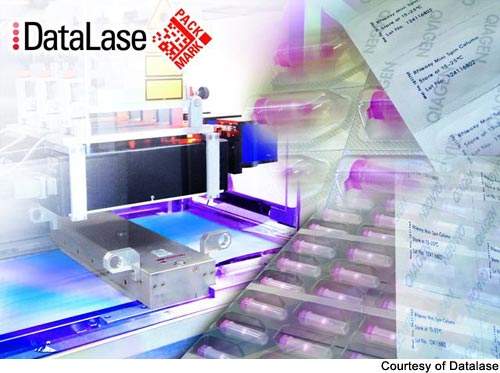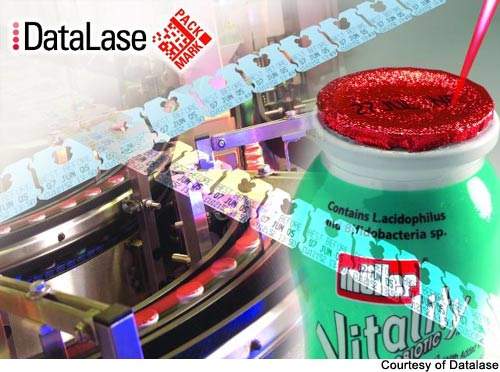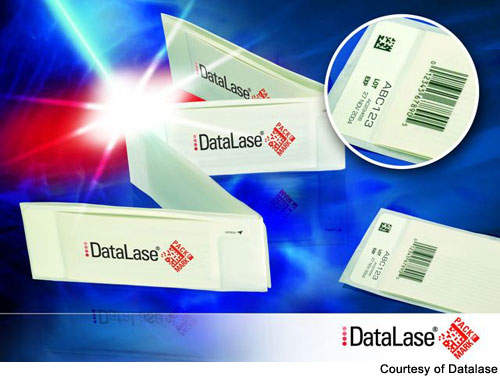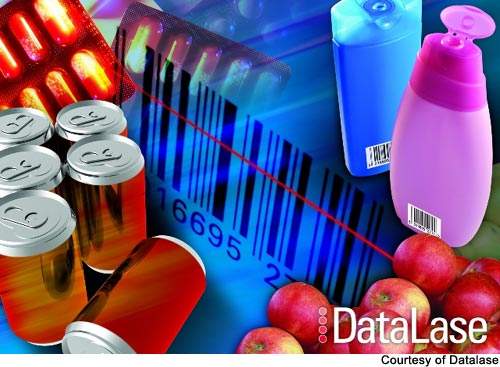With nutritional labelling and traceability information becoming increasingly widespread, the advent of a flexible labelling system that can be used in conjunction with a production line at the fastest line speed is a boost for many companies.
With the trend for the display of variable information on the front of primary packaging and pre-printed wraps, it can be quite expensive to change a label to include additional information at a moment’s notice. The Datalase Packmark labelling system addresses this issue through its high-speed, low power CO2 laser print system, which marks on packages at the final stage of production/packaging.
The Packmark system uses a transparent pigment, which is applied to the area of the pack to be marked. This is then left blank, allowing the laser to return to it if more information is required. The pigment reacts to the laser light and changes colour from transparent to black. Thermal printing and laser printing systems are not new but the Datalase system provides significant advantages in that the laser has a lifetime of 30,000 hours and requires only minimum maintenance.
The Packmark system process
Labelling can be changed almost at the last minute, allowing a degree of flexibility. The system is completely compatible with the highest speeds of production. The transparent pigment was granted a European patent for the company in April 2007. The company also holds a patent in the US and Japan.
In October 2007, Datalase won another patent for a new transparent pigment. The new pigment was an addition to Datalase’s product range and can be used on clear films or substrates.
Applications
The system is proving to have particular application in the pharmaceutical sector where date, lot and batch information have traditionally been embossed or thermally printed on product packages.
The Datalase system has allowed pharmaceutical packaging companies such as Domino Amjet and Schreiner to change to a faster, laser-powered process and also to increase the sophistication of their added labelling. Datalase Packmark is also being used by QIAGEN for labelling on the lids of blisterpacks.
The Datalase system can also be used to introduce additional security into packaging to help combat counterfeiting as 2D bar codes, conventional bar codes and high resolution sophisticated designs can be printed onto packs if required.
Datalase were to link up with FractureCode to produce an anti-counterfeiting track-and-trace system that would involve laser printing to the pigment under a transparent coating to avoid tampering.
However, the plan was withdrawn after a patent infringment case came up between Orbid, a unique identity systems provider, and FractureCode.
The system provides a simple (no ink required), maintenance-free, accurate, high-resolution labelling system for use across a wide range of industries including food, pharmaceuticals, tobacco and scientific consumables.
Future Datalase systems
Pharmamark is a similar system that can print information directly onto tablets of drugs (such as expiry date, product logo and the name of the medication). The pigment is applied via a tablet coating process and is completely edible. The Foodmark uses a pigment sprayed directly onto fresh food such as apples, which can be marked by a low-power laser to apply a label such as a best before date or the name of the variety.
Datalase markets a range of inks called Chemithermal which work over a range of colours that are activated at different temperatures. When incorporated into a label they provide an indication/record of the highest temperature the package and label have been exposed to.







